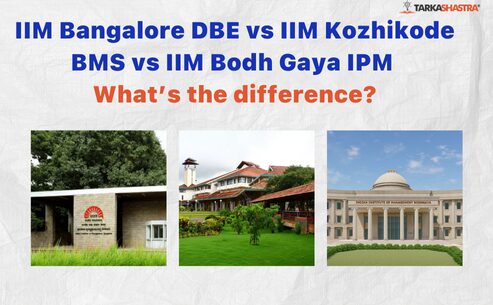If you’re aiming for admission into IIM Indore or IIM Rohtak after Class 12, the IPMAT 2026 exam is your first—and most important—milestone. But preparing for the IPMAT isn’t just about solving Quant questions or improving vocabulary. It starts with something far more fundamental: understanding the exam’s total marks and how they’re distributed.
Why does this matter?
Because the total marks, question formats, and marking rules influence everything—your mock test strategy, time allocation, risk-taking in MCQs, and ultimately your final score.
Many aspirants make the mistake of treating both IPMAT Indore and IPMAT Rohtak as similar exams. Still, the marking schemes are significantly different and require distinct preparation approaches.
Let’s take a quick glance at why knowing the marks distribution is critical:
| Why Understand IPMAT Total Marks? | How It Helps You Strategize |
| Different exams = different marking patterns | Tailor your mock tests for each IIM’s paper structure |
| Sections carry different weightage | Allocate prep hours smartly instead of equally |
| Negative marking in some sections, none in others | Decide when to guess and when to skip |
| SA questions are risk-free (Indore only) | Attempt confidently without fear of losing marks |
| Verbal Ability has highest weight in Indore | Don’t ignore it even if you’re Quant-heavy |
At Tarkashastra, we’ve seen hundreds of students miss the cut-off—not because they didn’t know the syllabus—but because they didn’t understand where to score and where to stay safe.
This blog will decode:
- The total marks and section-wise distribution in both IPMAT Indore and IPMAT Rohtak
- The negative marking rules
- Comparison of both exams
- Mistakes to avoid and how to create your preparation plan based on this marking strategy
Let’s now break down both exams, starting with their structural overview.
IPMAT 2026 Overview – Indore vs Rohtak
The Integrated Program in Management Aptitude Test (IPMAT) is conducted separately by IIM Indore and IIM Rohtak for admission into their 5-Year Integrated Program in Management (IPM). While both exams share a common goal—testing your aptitude for management education after Class 12—their formats, sections, and marking schemes vary significantly.
Understanding this structural difference is the first step to planning an innovative preparation strategy. Here’s a quick side-by-side comparison:
IPMAT Indore vs IPMAT Rohtak – 2026 Exam Format
| Feature | IIM Indore | IIM Rohtak |
| Total Questions | 90 | 120 |
| Total Marks | 360 | 480 |
| Number of Sections | 3 | 3 |
| Sections | Quant (MCQ), Quant (SA), Verbal (MCQ) | Quant (MCQ), Verbal (MCQ), Logical Reasoning (MCQ) |
| Type of Questions | MCQ + Short Answer | All MCQs |
| Presence of Logical Reasoning | Not Included | Included |
| Short Answer Questions (SA) | Yes (Quant Section) | No |
| Negative Marking | –1 (only in MCQs); No penalty in SA | –1 (in all questions) |
| Sectional Time Limit | Yes (40 minutes per section) | No fixed sectional timing |
| Exam Duration | 120 minutes | 120 minutes |
| Language of the Exam | English | English |
What Does This Mean for You?
- IPMAT Indore rewards conceptual clarity and precision. Its SA section, which carries no negative marking, offers a strategic scoring opportunity if you’re confident in Quant.
- IPMAT Rohtak, on the other hand, tests your speed and accuracy equally across all three sections, with no room for safe guessing due to universal negative marking.
If you’re preparing for both exams, you cannot follow a one-size-fits-all approach. The exam structure should dictate how you plan mocks, revise topics, and manage your time during the test.
IPMAT Indore 2026 – Section-Wise Total Marks Distribution
IPMAT Indore is known for its unique question format and sectional timing, making it a slightly more conceptual and time-pressured exam. What sets it apart is the Short Answer (SA) section, which offers a golden opportunity: +4 marks per correct answer and no negative marking for incorrect ones.
Here’s how the marks are distributed across the three sections:
IPMAT Indore 2026 – Section-Wise Marks Distribution
| Section | No. of Questions | Marks per Question | Total Marks | Negative Marking |
| Quantitative Ability (MCQ) | 30 | +4 | 120 | –1 per incorrect answer |
| Quantitative Ability (Short Ans) | 15 | +4 | 60 | No negative marking |
| Verbal Ability (MCQ) | 45 | +4 | 180 | –1 per incorrect answer |
| Total | 90 | — | 360 | Mixed (MCQ only) |
Sectional Time Limits
In IPMAT Indore, each section is strictly timed for 40 minutes. You cannot switch sections once the timer ends, making real-time decision-making and question selection extremely important.
| Section | Time Allotted |
| Quantitative Ability (SA) | 40 minutes |
| Quantitative Ability (MCQ) | 40 minutes |
| Verbal Ability (MCQ) | 40 minutes |
| Total Exam Duration | 120 minutes |
Key Takeaways for IPMAT Indore Aspirants
- SA Section = Scoring Zone: With no penalty for wrong answers, it’s a safe bet for calculated attempts—even when you’re unsure.
- Verbal Dominates the Paper: 45 out of 90 questions = 50% of the total paper. Ignoring this section is a costly mistake.
- Dual Quant Sections: If you’re strong in Quant, IPMAT Indore plays to your strengths, but you need to be good at both formats (MCQ and typed SA).
- Time Strategy is Crucial: With sectional locks, mock-test-based time practice is non-negotiable.
Pro Tip from Tarkashastra: Practice typing numeric answers accurately under time pressure for the SA section. Many students lose marks not due to conceptual errors, but typing mistakes!
IPMAT Rohtak 2026 – Section-Wise Total Marks Distribution
Unlike its Indore counterpart, IPMAT Rohtak follows a uniform and speed-intensive structure. It consists of 120 MCQ-based questions, equally distributed across Quantitative Ability, Logical Reasoning, and Verbal Ability, with no Short Answer (SA) section and no sectional timing.
This structure makes accuracy, balance, and time management the keys to scoring well.
IPMAT Rohtak 2026 – Section-Wise Marks Distribution
| Section | No. of Questions | Marks per Question | Total Marks | Negative Marking |
| Quantitative Ability | 40 | +4 | 160 | –1 per incorrect answer |
| Logical Reasoning | 40 | +4 | 160 | –1 per incorrect answer |
| Verbal Ability | 40 | +4 | 160 | –1 per incorrect answer |
| Total | 120 | — | 480 | Yes (all sections) |
Time Management Advantage: No Sectional Timing
One of the most defining features of IPMAT Rohtak is the absence of sectional timers. You get 120 minutes to attempt 120 questions, and you’re free to move across sections as you wish.
| Feature | Details |
| Total Exam Duration | 120 minutes |
| Section Switching | Allowed |
| Section-Wise Time Allocation | Not Fixed |
| Question Type | MCQ Only |
| Language of the Exam | English |
Key Takeaways for IPMAT Rohtak Aspirants
- All Sections Carry Equal Weight: You cannot afford to neglect any one area—Verbal, Quant, or Logical Reasoning.
- Guesswork is Risky: Every wrong answer carries 1. Attempt only when 70–80% sure.
- Logical Reasoning Is Crucial: It’s not tested in Indore, but forms one-third of Rohtak’s exam. Daily LR practice is a must.
- No Time Locks, But Don’t Relax: The flexible time format can be a double-edged sword—if you spend too long in one section, others suffer.
Pro Tip from Tarkashastra: Train yourself to spend no more than 1 minute per question. Practice mock tests where you track time spent per section to develop smart pacing habits.
With the individual distributions covered, let’s now compare both exams side by side to help you build a dual-exam strategy.
Key Differences in Marking Schemes – IIM Indore vs IIM Rohtak
While both exams fall under the IPMAT umbrella, IIM Indore and IIM Rohtak test entirely different skills—and that’s reflected in their marking schemes. Understanding how marks are awarded (and deducted) is crucial for optimising your attempt strategy, especially when attempting both exams.
Let’s break it down:
IPMAT 2026 – Marking Scheme Comparison Table
| Feature | IIM Indore | IIM Rohtak |
| Total Questions | 90 | 120 |
| Total Marks | 360 | 480 |
| Sections | Quant (MCQ + SA), Verbal (MCQ) | Quant, Verbal, Logical Reasoning (All MCQs) |
| Question Types | MCQ + Short Answer | MCQ Only |
| Short Answer Questions | Yes (15 in Quant) | No |
| Logical Reasoning Section | Not Included | Included (40 questions) |
| Negative Marking in MCQs | –1 per wrong answer | –1 per wrong answer |
| Negative Marking in SA | None | Not Applicable |
| Section Without Negative Marking | Quant (Short Answer) | None |
| Sectional Time Limit | Yes (40 minutes per section) | No |
| Scoring Focus | Conceptual depth + risk-free SA | Speed + balanced accuracy across all sections |
How These Differences Impact Your Exam Strategy
IIM Indore Strategy Takeaways:
- The Short Answer section is your best friend—no negative marking, high conceptual value, and often predictable questions.
- Verbal carries 50% weight (180 out of 360 marks)—don’t make it your weak link.
- Sectional timers demand strict time discipline—you can’t carry over spare minutes from one section to another.
IIM Rohtak Strategy Takeaways:
- With equal weightage across all three sections, you need balanced prep. Weakness in any one section can tank your score.
- No SA safety net—all questions penalise errors, so accuracy is king.
- You get freedom in time allocation, but that doesn’t mean you can afford to overthink or get stuck.
Quick Decision Matrix for Students Targeting Both Exams
| If You’re Strong In… | Prioritize |
| Quantitative Concepts | IPMAT Indore |
| Logical Thinking & Fast Problem Solving | IPMAT Rohtak |
| Verbal Ability | Both (especially Indore) |
| Accuracy Over Guessing | Indore SA section |
| Managing Flexible Time Format | Rohtak |
Tarkashastra Tip: Create two distinct test-taking strategies during your mocks—one with a focus on precision and SA attempts for Indore, and another with speed + balanced section approach for Rohtak. You’ll avoid the “one strategy fits all” trap.
Why Total Marks & Sectional Weightage Matter in Preparation
Many students begin their IPMAT prep by randomly solving questions or watching videos, without knowing which sections matter more or where most marks lie. This leads to wasted effort and poor ROI on your study hours.
But when you understand the total marks and sectional weightage, you shift from a “general study” mindset to a targeted, score-maximising strategy.
Let’s decode why that matters.
Section-Wise Weightage Breakdown
IPMAT Indore – Sectional Contribution to Total Marks
| Section | Marks | % of Total Marks (360) |
| Verbal Ability (MCQ) | 180 | 50% |
| Quantitative Ability (MCQ) | 120 | 33.3% |
| Quantitative Ability (Short Ans) | 60 | 16.7% |
- Verbal dominates the paper
- Short Answer is low-risk, high-reward
IPMAT Rohtak – Sectional Contribution to Total Marks
| Section | Marks | % of Total Marks (480) |
| Quantitative Ability | 160 | 33.3% |
| Logical Reasoning | 160 | 33.3% |
| Verbal Ability | 160 | 33.3% |
- Perfectly balanced paper
- No scoring cushion or low-risk section
Why Knowing This Changes Everything
1. Better Time Allocation
If you’re preparing for IPMAT Indore and ignoring Verbal, you’re losing out on half the paper’s value. Similarly, if you’re weak in Logical Reasoning and aiming for Rohtak, you’re compromising one-third of your score.
2. Efficient Study Planning
Use the weightage data to allocate prep hours proportionately:
| Section | % of Weekly Study Time (Indore) | % of Weekly Study Time (Rohtak) |
| Verbal Ability | 40–45% | 30–35% |
| Quantitative Ability | 40–45% | 30–35% |
| Logical Reasoning | Not Required | 30–35% |
Impact on Mock Test Strategy
- For Indore: If you’re scoring low in Verbal, your total score may still look good, but you’ll miss the cutoff. Focus on sectional improvement.
- For Rohtak: Don’t let one section lag by 20+ marks. Even a 10-mark gap can affect your percentile due to normalisation.
Target Cutoffs and Safe Scores
| Institute | Safe Raw Score | Sectional Focus |
| IIM Indore | 300+ out of 360 | Clear all section cutoffs; Verbal & SA |
| IIM Rohtak | 400+ out of 480 | Maintain balance across all sections |
Bottom Line? Study Smarter, Not Just Harder
“Don’t study everything equally. Study what scores you the most.”
When you use total marks and section weightage to drive your preparation strategy, you stop wasting energy and start building a paper-cracking plan.
Negative Marking Rules in Detail
Understanding where you lose marks is just as important as knowing where to gain them. Both IPMAT Indore and IPMAT Rohtak penalise incorrect answers—but not in the same way.
Let’s explore the exact negative marking policies and how they impact your attempt strategy.
Negative Marking – Section-Wise Breakdown
IPMAT Indore – Penalty Only in MCQs
SectionQuestion TypeNegative Marking
| Section | Question Type | Negative Marking |
| Quantitative Ability (MCQ) | MCQ | –1 for incorrect answer |
| Quantitative Ability (Short Ans) | Short Answer | No negative marking |
| Verbal Ability (MCQ) | MCQ | –1 for incorrect answer |
- You lose marks only in MCQs.
- SA questions are risk-free—either you gain +4 or score zero.
IPMAT Rohtak – Penalty in Every Section
| Section | Question Type | Negative Marking |
| Quantitative Ability | MCQ | –1 for incorrect answer |
| Logical Reasoning | MCQ | –1 for incorrect answer |
| Verbal Ability | MCQ | –1 for incorrect answer |
- No safe zones.
- Every incorrect attempt deducts 1 mark—across all sections.
Summary Table: IPMAT Indore vs Rohtak – Negative Marking Policies
| Feature | IIM Indore | IIM Rohtak |
| MCQs | –1 per wrong answer | –1 per wrong answer |
| Short Answer (SA) | No negative marking | Not Applicable |
| Section without negative marking | Quantitative Ability (SA) | None |
| Overall Risk Level | Moderate (if SA is utilized wisely) | High (guessing can be costly) |
Strategic Implications
For Indore:
- Exploit the SA section: With no penalty, you have nothing to lose. Attempt all 15 SA questions—even if unsure.
- Be cautious in MCQs: Don’t blindly guess unless you can eliminate at least 2 options.
For Rohtak:
- Precision > Attempt Rate: Attempt only when you’re 70–80% confident.
- No risk-free section: Even 5–6 wrong guesses can pull your percentile down drastically.
Avoid These Common Mistakes
| Mistake | Smarter Alternative |
| Blind guessing in MCQs | Attempt only with option elimination |
| Ignoring SA section in Indore | Treat it as a scoring opportunity with zero risk |
| Rushing to increase attempts | Focus on accuracy—even if attempts are lower |
| Overconfidence in Verbal MCQs | Double-check RC inference questions |
Tarkashastra Tip: Practice a decision matrix while solving mocks: “If unsure → eliminate → check risk → attempt or skip?”
Build this habit to avoid subconscious negative marking mistakes.
Strategies to Maximise Score Based on Mark Distribution
By now, you know that IPMAT Indore and Rohtak are structurally different, with varied weightages and negative marking rules. But knowing that isn’t enough—you must use this insight to tailor your prep, mocks, and attempt to maximise marks while minimising risk.
Let’s break it down.
IPMAT Indore Strategy – Play Smart with SA and Time
1. Prioritise the Short Answer (SA) Section
| Why It Works | Action Plan |
| No negative marking = risk-free scoring | Attempt all 15 SA questions—even if unsure |
| Often covers fundamental Quant topics | Revise Arithmetic, Algebra, Number Theory basics |
| Easy to lose marks due to typing mistakes | Practice clean, accurate on-screen numeric input |
2. Be Cautious in MCQ Sections
- Don’t guess blindly—MCQs have 1 penalty
- Use option elimination or skip if you’re less than 60% sure
- Track accuracy in mocks; aim for 80%+ correct in MCQ sections
3. Master Sectional Time Management
- You get 40 minutes per section, and the system auto-locks each one.
- Practice mock tests with timers to build speed & rhythm
- Avoid spending >2 minutes per question unless it’s an SA
4. Capitalise on Verbal Ability (180 Marks)
- Verbal = 50% of the paper
- Focus on Reading Comprehension, Grammar, and Para Jumbles
- Daily reading of editorials, fiction, and non-fiction boosts RC performance
Ideal Attempt Strategy for IIM Indore
| Section | Attempts Target | Accuracy Target | Notes |
| Quant (SA) | 15/15 | 60–70% | Attempt all; practice typing-based solving |
| Quant (MCQ) | 20–24 | 75–85% | Attempt selectively with caution |
| Verbal (MCQ) | 40–45 | 80–90% | Maximize attempts, focus on speed & vocab |
IPMAT Rohtak Strategy – Balance & Accuracy Over Volume
1. Use Your 120 Minutes Wisely
- You’re free to switch between sections—leverage that.
- Spend more time on your stronger sections, but avoid overcommitting.
- Use mock analysis to track where time is leaking.
2. Accuracy > Attempt Rate
- With negative marking in every section, don’t attempt just to “finish the paper”
- Ideal attempts: 90–100 with 85% accuracy
- Avoid back-to-back guesses—it increases the chance of a score dip
3. Practice Logical Reasoning Daily
- Unique to Rohtak, yet often neglected
- Focus on: Puzzles, Coding-Decoding, Blood Relations, Series
- Allocate a daily 30–45 min LR practice slot
4. Don’t Overlook Verbal
- Even though it feels easy, Verbal cutoffs are rising
- RC + Grammar = ~60% of this section
- Use timed RC sets to improve both comprehension + stamina
Ideal Attempt Strategy for IIM Rohtak
| Section | Attempts Target | Accuracy Target | Notes |
| Quant | 28–32 | 80–90% | Prioritize speed-friendly topics |
| Logical Reasoning | 30–34 | 80–85% | Don’t skip this; daily practice needed |
| Verbal Ability | 32–36 | 85–90% | Build speed with timed RC + grammar drills |
Pro Tip: Design a Dual Exam Strategy Like This
| Area | For IIM Indore | For IIM Rohtak |
| Focus Area | SA + Verbal + Conceptual QA | Speed + Accuracy + Balanced Sections |
| Time Plan | Sectional mocks with timers | Full-length mocks with self-paced timing |
| Guessing Rule | Avoid in MCQs, attempt all SA | Only attempt if 80%+ confident |
| Preparation Approach | Concept clarity > question volume | Sectional balance > topic depth |
Tarkashastra Tip: Track your performance not just by total score, but section-wise net score (Correct × 4 – Wrong × 1). This is how the actual IPMAT evaluation works.
Common Mistakes Related to Marks Distribution
You can prepare hard. You can practice daily. But if you don’t align your attempt strategy with how marks are actually awarded—and penalised—you may lose out despite knowing the concepts.
Let’s look at the most frequent mistakes IPMAT aspirants make when it comes to marks, weightage, and scoring—and what you should do instead.
1. Blind Guessing in MCQs (Especially Rohtak)
| In Indore | In Rohtak |
| Each section is locked for 40 mins—you can’t switch | No section timer, but easy to lose track of balance |
| Overcommitting to Quant leaves Verbal underdone | Spending 50+ mins on one section = disaster |
2. Ignoring the SA Section in Indore
- Many students fear the Short Answer section because there are no options and answers must be typed.
- But this is the only risk-free section in the entire paper.
- You either score +4 or 0, with no negative marking.
Solution:
Treat the SA section as a scoring goldmine—practice clean calculation, typing discipline, and commonly asked patterns.
3. Poor Time Allocation in Timed Sections
| In Indore | In Rohtak |
| Each section is locked for 40 mins—you can’t switch | No section timer, but easy to lose track of balance |
| Overcommitting to Quant leaves Verbal underdone | Spending 50+ mins on one section = disaster |
Fix:
- Simulate mocks with strict timers (Indore)
- Use section-wise time checkpoints during full-length mocks (Rohtak)
4. Over-Attempting in a Race Against Time
- In Rohtak, many students feel compelled to “attempt all 120 questions”.
- But this isn’t a board exam. With 1 for every wrong attempt, it’s easy to sink below the cutoff even after a decent number of correct answers.
Smart Attempt Plan:
- Target 90–100 attempts with 85–90% accuracy
- Skip questions where you’re less than 60% sure
5. Underestimating Verbal Ability
- Verbal Ability accounts for:
- 50% of marks in Indore (180/360)
- One-third of the marks in Rohtak (160/480)
- Yet, many Quant-focused students leave it for last-minute prep.
Reminder:
- In IPMAT 2024, Verbal had the highest cutoff in IIM Indore.
- Reading comprehension and grammar can be high scoring with low time investment—don’t skip.
Mistake-to-Fix Summary Table
| Mistake | What to Do Instead |
| Blind guessing in MCQs | Eliminate options; attempt only if 70%+ confident |
| Ignoring SA in Indore | Attempt all 15 SA questions with smart logic |
| Poor section timing | Practice with strict mocks and pacing checkpoints |
| Attempting all 120 questions (Rohtak) | Prioritize accuracy; aim for 90–100 good attempts |
| Neglecting Verbal Ability | Daily RC + grammar practice; it’s a high-weight section |
Tarkashastra Tip: After every mock, ask yourself: “Where did I lose marks—not because of knowledge, but because of poor attempt strategy?”
That question alone can push your performance up by 30–40 marks in just a few weeks.
Final Thoughts – Master the Marking Scheme, Maximize Your Rank
The difference between clearing IPMAT and cracking IPMAT often boils down to not what you study, but how well you understand the exam’s blueprint.
And that blueprint starts with just one thing: Total Marks and Their Distribution.
What You Should Take Away from This Blog
| Insight | Impact on Your Prep |
| Indore = 360 marks; Rohtak = 480 marks | Study plans and mock cutoffs should reflect this difference |
| Verbal is 50% of Indore; 33% of Rohtak | Never treat Verbal as optional or secondary |
| SA section in Indore = risk-free marks | Practice it like a bonus round—attempt all, even with smart guessing |
| Rohtak = Negative marking everywhere | Precision > volume; don’t aim to solve all 120 questions |
| Different time rules: Indore (fixed), Rohtak (free) | Train with both styles of mocks: sectional and full-length |
Your Strategic Advantage = Pattern Awareness
Too many aspirants prepare for IPMAT like a syllabus-based school exam. But what the toppers do differently is study based on scoring weightage and negative zones.
Here’s a final recap on what matters most:
| Area | Indore Strategy | Rohtak Strategy |
| Key Scoring Section | SA + Verbal Ability | Balanced across all three (QA, LR, VA) |
| Guessing Strategy | Smart guessing allowed in SA (no negative) | Very limited guessing—penalty in every section |
| Time Management | Fixed 40 minutes per section | Flexibility, but risk of overspending time |
| Attempt Style | Selective in MCQs, complete in SA | Focused attempts (~90–100), high accuracy |
| Prep Focus | Concept clarity + typing accuracy (SA) | Sectional balance + stamina + puzzle speed |
Tarkashastra’s Approach: Score-Driven, Not Just Syllabus-Driven
At Tarkashastra, we train IPMAT aspirants not just to “complete the syllabus,” but to:
- Understand exam scoring logic
- Build risk-aware test strategies
- Optimise time per section
- Track mock performance by net gain, not just the number of attempts
Because when the paper comes, it’s not about who studied the most… It’s about who scored the most.
Ready to Build Your Strategy?
Whether you’re targeting IIM Indore, IIM Rohtak, or both, your prep plan should begin with the marks and end with the marks.
And this guide is your compass.
Need help creating your IPMAT 2026 game plan?
Join Tarkashastra’s IPMAT coaching for:
- Daily live sessions
- Mock-based prep
- Doubt-solving with IIM alumni mentors
- Real-time scoring strategy workshops
Explore our programs at www.tarkashastra.co.in
FAQs – IPMAT Total Marks & Marking Scheme
1. What is the total mark of IPMAT Indore 2026?
The IPMAT Indore 2026 exam carries a total of 360 marks. It includes 90 questions across three sections: Quantitative Ability (MCQ), Quantitative Ability (Short Answer), and Verbal Ability (MCQ). Each correct answer gives +4 marks, and some sections have negative marking.
2. What is the total mark of IPMAT Rohtak 2026?
IPMAT Rohtak is scored out of 480 marks, with a total of 120 questions. These are evenly distributed across Quant, Logical Reasoning, and Verbal Ability. Each correct answer gives +4 marks, and each wrong attempt deducts 1 mark.
3. How many sections are there in IPMAT Indore?
There are three sections in IPMAT Indore: Quantitative Ability (MCQ), Quantitative Ability (Short Answer), and Verbal Ability (MCQ). Each section has a fixed time limit of 40 minutes. This structure tests both conceptual depth and time management.
4. How many questions are in the IPMAT Indore exam?
The total number of questions in IPMAT Indore is 90. These include 30 Quant MCQs, 15 Quant Short Answer questions, and 45 Verbal MCQs. The combination of MCQ and SA types makes the paper unique.
5. What’s the question distribution in IPMAT Rohtak?
IPMAT Rohtak contains 120 multiple-choice questions, divided equally across three sections. There are 40 questions each in Quant, Logical Reasoning, and Verbal Ability. All questions are MCQ-based and carry equal weightage.
6. Is there negative marking in IPMAT Indore?
Yes, but only in the MCQ sections—Quant (MCQ) and Verbal (MCQ). Each incorrect MCQ carries a penalty of 1 mark. However, the Short Answer (SA) section has no negative marking, making it a safe scoring area.
7. Is there negative marking in IPMAT Rohtak?
Yes, all 120 questions in IPMAT Rohtak are MCQs and include negative marking. You get +4 for a correct answer and 1 for a wrong one. There’s no section in Rohtak without penalty, so accuracy is critical.
8. Which section has the highest weightage in IPMAT Indore?
The Verbal Ability (MCQ) section carries 180 marks out of the total 360. That’s a massive 50% weightage, making it the most crucial section in terms of scoring potential. Ignoring it can drastically affect your final score.
9. Are all sections equally weighted in IPMAT Rohtak?
Yes, each of the three sections in IPMAT Rohtak carries 160 marks. This means Quant, Verbal, and Logical Reasoning each contribute one-third to the total score. You must perform well in all three to rank high.
10. What is the Short Answer (SA) section in Indore?
The SA section in Quantitative Ability asks you to type numeric answers without any options. It has 15 questions and carries 60 marks. The best part—it has no negative marking, offering risk-free scoring if prepared well.
11. Can I skip the SA section in IPMAT Indore?
You can technically skip it, but doing so would be a strategic mistake. The SA section has no negative marking and includes many questions from commonly asked Quant topics. Attempting all 15 questions gives you free chances to score without the risk of penalties.
12. Is Logical Reasoning asked in IPMAT Indore?
No, Logical Reasoning is not part of the IPMAT Indore paper. Indore focuses more on high-level Quantitative and Verbal skills. So, students preparing only for Indore can choose to skip LR in their preparation.
13. Does IPMAT Rohtak have a Short Answer section?
No, IPMAT Rohtak does not include any Short Answer (SA) questions. All 120 questions are MCQs across Quant, Verbal, and Logical Reasoning. This uniformity makes it a speed and accuracy-based test without safe scoring zones.
14. How is the score calculated in both exams?
The score is calculated as: (Correct Answers × 4) – (Wrong Answers × 1). Unattempted questions don’t add or deduct anything. This makes accuracy more important than the sheer number of attempts.
15. Is there any section without negative marking in IPMAT Rohtak?
No, all three sections in IPMAT Rohtak carry equal weight and apply 1 for every incorrect answer. Unlike Indore’s SA section, Rohtak offers no negative marking exemptions. Precision in every section is critical.
16. What’s the minimum score required to be safe in IPMAT Indore?
A safe raw score in IPMAT Indore is considered to be 300+ out of 360 for the general category. However, you must also clear the individual sectional cutoffs, especially in Verbal and Quant SA, to receive an interview call.
17. What’s the safe score range for IPMAT Rohtak?
A score of around 400 to 430 out of 480 is considered safe for general category aspirants. Since Rohtak does not have sectional cutoffs, maintaining consistent accuracy across all three sections is the key to crossing the cutoff.
18. Can I pass IPMAT with a low score in one section?
Only in IPMAT Rohtak, where selection is based on the overall score. In IPMAT Indore, however, you must clear sectional cutoffs in all three sections—so a low score in any one section, even with a high total, can disqualify you.
19. Do unattempted questions reduce your score?
No, there is no penalty for leaving questions blank in either exam. In fact, skipping uncertain questions is often a more brilliant move than guessing, especially in Rohtak, where every wrong answer deducts a mark.
20. Should I attempt all questions in IPMAT Rohtak?
Not necessarily. While it may seem tempting to attempt all 120 questions, it’s risky due to negative marking. It’s better to try 90–100 questions with high accuracy rather than risk a score drop due to incorrect guesses.
21. Which section is the easiest to score in?
In IPMAT Indore, the SA section is often the easiest to score due to no negative marking. In Rohtak, students usually find Verbal Ability easier with practice, mainly if they focus on Reading Comprehension and Grammar.
22. How much time is allotted per section in Indore?
Each of the three sections in IPMAT Indore is timed for 40 minutes, making a total of 120 minutes. You cannot switch between sections or carry time forward, so you must manage speed and accuracy within each time block.
23. Does Rohtak have a sectional timer?
No, IPMAT Rohtak gives you 120 minutes total without dividing time between sections. You can switch freely between Quant, Verbal, and Logical Reasoning, allowing flexibility in time allocation as per your strengths.
24. What should be my ideal attempt strategy?
For Indore: attempt all SA questions, and be selective yet accurate in MCQs. For Rohtak: aim to try around 90–100 questions with 85–90% accuracy. Don’t aim for full attempts unless you are confident in every answer.
25. Why should I align my prep with the marks structure?
Because IPMAT is not just about knowing concepts—it’s about knowing where the marks are, where the traps lie, and how to play safe or aggressive accordingly. Preparation aligned with the marking scheme ensures maximum output for your effort.







